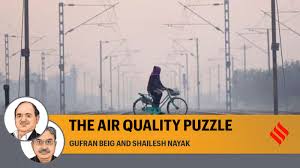12 May 2025 Indian Express Editorial
What to Read in Indian Express Editorial( Topic and Syllabus wise)
Editorial 1 : The Air Quality Puzzle
Context: India’s air pollution strategy needs atmanirbharta.
Introduction: The Make in India initiative has boosted the morale of the country’s youth. From Chandrayaan to Covid-19 vaccines and Vande Bharat trains, India has proved its mettle. But, when it comes to improving air quality and mitigating the health impacts of pollution, India lags behind.
Key Achievements: Improving Air Quality
- Indigenous Innovations: Development of SAFAR (2010), India’s first air quality forecasting system.
- Past Milestones
- National Ambient Air Quality Monitoring Programme (1984).
- Delhi’s CNG-based public transport transition.
- Institutional Strengths
- Presence of agencies like ESSO (Earth System Science Organisation) and IMD (India Meteorological Department).
- Recent initiatives like the Anusandhan National Research Foundation to promote industry-R&D collaboration.
Persistent Challenges
- Air Quality Crisis
- Indian cities consistently rank among the world’s most polluted.
- Health and economic impacts of pollution remain unmitigated.
- Structural Gaps
- Funding Issues: Pollution control boards frequently return unspent funds despite claims of financial shortages.
- Research Dependency: Over-reliance on foreign-funded studies and data (e.g. US climate research shutdown under Trump exposed vulnerabilities).
- Limited Reach: Indigenous systems like SAFAR restricted to only four cities.
- Governance & Collaboration
- Fragmented efforts between institutions (e.g. weak ESSO-IMD-CPCB collaboration).
- City-centric approaches instead of integrated airshed management.
Foreign Influence and Concerns
- Questions Raised
- Why are developed nations funding air quality studies in India despite having no direct stake?
- Why are Indian institutions not leading research on domestic air pollution?
- Implications
- Risks of data dependency and unequal climate sanctions in global frameworks.
- Foreign-funded projects often prioritize elite institutions, sidelining local expertise.
Way Forward: Strategic Recommendations
- Indigenous Solutions
- Launch polar-orbiting satellites for independent global data collection.
- Scale successful models like SAFAR nationwide.
- Integrated Frameworks
- NARFI(National Air Quality Resource Framework): Proposed unified platform for interdisciplinary collaboration, knowledge-sharing, and evidence-based policymaking.
- Shift from city-centric to airshed management strategies.
- Strengthening Institutions
- Enhance ESSO-IMD-CPCB collaboration to set global benchmarks.
- Prioritize health-centric measures and food security in pollution control.
- Funding & Equity
- Address disparities in resource allocation to avoid funnelling funds to select institutions.
- Encourage industry sponsorship and diversify international partnerships.
Case Studies & Lessons
- Delhi’s CNG Transition: Demonstrated rapid policy impact but lacked scalability.
- SAFAR’s Limitations: Successful but confined to four cities due to institutional inertia.
- EV Adoption: States like Kerala and Maharashtra show promise in sustainable transitions.
Conclusion: India’s air quality crisis demands urgent structural reforms, including decentralized research, equitable funding, and integrated governance. By leveraging existing institutions, scaling indigenous innovations, and adopting airshed-based strategies, India can achieve true atmanirbharta in pollution control while contributing to global climate goals.
Editorial 2 : Stitching a New Story
Context: India-UK FTA and India’s textile sector
Overview of the India-UK FTA
- Key Provisions
- Zero-duty access for Indian industrial goods.
- Tariff elimination on 99.3% of animal products, 99.8% of vegetable/oil products, and 99.7% of processed foods.
- Reduced tariffs on British imports
- Whiskey and gin: Tariffs cut from 150% to 75% (phased reduction to 40% over 10 years).
- British cars: Tariffs reduced from 100% to 10%.
- Ambitious Target: Aim to increase bilateral trade from $23.3 billion to $120 billion by 2030
Current Trade Dynamics
- UK’s Global Trade Profile (2024)
- Imports: $815.5 billion
- Exports: $512.9 billion
- India-UK Trade Composition
- Indian exports to UK: Machinery, mineral fuels, pharmaceuticals, apparel, and footwear.
- UK exports to India: Pearls, nuclear reactors, spirits, and vehicles.
Opportunities for India’s Textile & Apparel (T&A) Sector
- Market Potential
- UK’s Apparel Imports: $26.9B (2024)
- UK’s apparel imports are dominated by China (25%), Bangladesh (20%) and India (6%).
- Post-FTA Advantage: Zero tariffs on Indian apparel vs. competitors’ 11–12% tariffs.
- Employment Impact
- T&A sector employs 45 million people in India.
- Access to high-end UK markets could boost labour-intensive sectors like footwear, toys, and apparel.
Structural Challenges in India’s T&A Sector
- Fragmented Manufacturing Base: MSMEs operate in silos across states, limiting economies of scale.
- Disjointed Value Chain: Geographical dispersion increases logistics costs and delays (63-day delivery time in India vs. 50 days in Bangladesh).
- Policy Issues with Manmade Fibers (MMF)
- Inverted GST structure: Higher taxes on inputs (fibres) than finished goods.
- Restrictive quality norms hinder global competitiveness.
Way Forward: Recommendations
- Policy Interventions
- Operationalize PM MITRA Parks:Focus on export-oriented hubs in Navsari (Gujarat) and Virudhunagar (Tamil Nadu).
- Simplify Compliance: Eliminate bureaucratic hurdles for exporters.
- Rationalize GST for MMF: Align tax structure to reduce input costs.
- Expand Trade Negotiations: Prioritize EU and US for zero-duty access.
- Industry Practices
- Global Aesthetics & Compliance
- Adopt ESG standards to comply with EU’s Corporate Sustainability Due Diligence Directive (CSDDD) by 2029.
- Embed traceability and green audits in supply chains.
- Logistics Efficiency: Reduce delivery timelines to match competitors like Bangladesh.
- Global Aesthetics & Compliance
- Product Innovation: Shift to High-Value Products
- Focus on activewear, athleisure, and technical textiles dominated by MMF.
- Invest in functional fabrics and integrate with global retail supply chains.
Conclusion: The India-UK FTA presents a transformative opportunity for India’s T&A sector. Realising the full potential hinges on integrated hubs to consolidate fragmented value chains, modern manufacturing practices aligned with global standards and proactive policy reforms to address structural inefficiencies.
![]()


